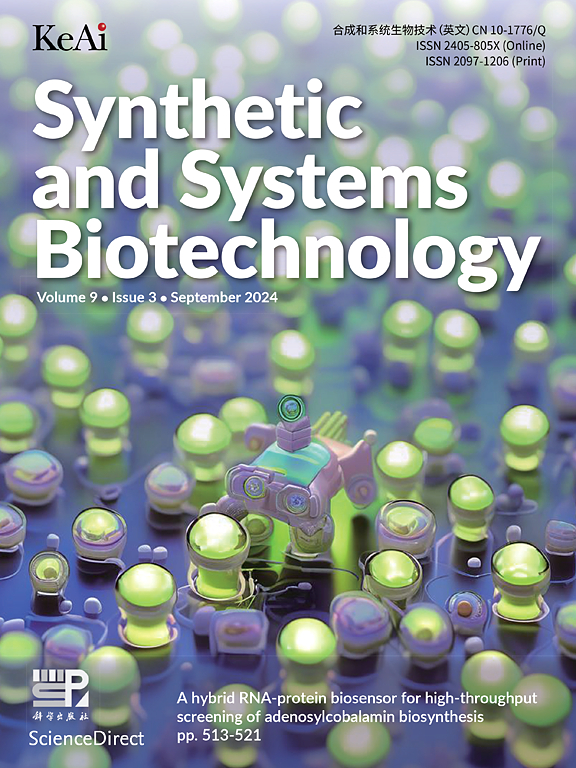Metabolic engineering of Escherichia coli for squalene overproduction
IF 4.4
2区 生物学
Q1 BIOTECHNOLOGY & APPLIED MICROBIOLOGY
引用次数: 0
Abstract
Squalene, a lipophilic triterpene with multifaceted bioactivities, faces bioproduction bottlenecks in microbial hosts due to inefficient biosynthetic pathways and limited storage capacity. Here, we address these challenges through systems metabolic engineering integrating redox-balanced 3-hydroxy-3-methyl glutaryl coenzyme A reductase (HMGR) variants and membrane lipid remodeling. By developing a hybrid HMGRs system combining NADPH-dependent and NADH-preferred enzymes, squalene production reached 852.06 ± 28.95 mg/L with balanced cofactor utilization. Subsequent engineering of membrane morphology and lipid metabolism generated lipid-enriched elongated cells, through the overexpression of dgs, murG and plsC, boosting squalene production to 970.86 ± 55.67 mg/L. Implementation of delayed induction strategies coupled with 10 % dodecane overlay as an in situ recovery system achieved a final squalene titer of 1267.01 mg/L in a 3 L bioreactor. Mechanistic studies revealed fatty acid (FA) and phosphatidylethanolamine (PE) as key reservoirs for squalene in E. coli, with dgs overexpression specifically promoting cellular elongation. This article provides comprehensive insights into engineering strategies and mechanistic perspectives, establishing a universal framework for hydrophobic metabolite biomanufacturing in prokaryotic hosts.
过量生产角鲨烯的大肠杆菌代谢工程
角鲨烯是一种具有多方面生物活性的亲脂性三萜,由于生物合成途径低效和储存能力有限,在微生物宿主中面临生物生产瓶颈。在这里,我们通过整合氧化还原平衡的3-羟基-3-甲基戊二酰辅酶A还原酶(HMGR)变体和膜脂重塑的系统代谢工程来解决这些挑战。通过建立nadph依赖酶和nadh优先酶的混合hmgr体系,角鲨烯产量达到852.06±28.95 mg/L,辅因子利用平衡。随后对膜形态和脂质代谢进行工程改造,通过过表达dgs、murG和plsC,生成富含脂质的细长细胞,使角鲨烯产量提高到970.86±55.67 mg/L。采用延迟诱导策略,加上10%十二烷覆盖作为原位回收系统,在3l生物反应器中最终获得了1267.01 mg/L的角鲨烯滴度。机制研究表明脂肪酸(FA)和磷脂酰乙醇胺(PE)是大肠杆菌中角鲨烯的关键储存库,dgs过表达特异性地促进细胞伸长。本文从工程策略和机理角度提供了全面的见解,建立了原核宿主中疏水代谢物生物制造的通用框架。
本文章由计算机程序翻译,如有差异,请以英文原文为准。
求助全文
约1分钟内获得全文
求助全文
来源期刊

Synthetic and Systems Biotechnology
BIOTECHNOLOGY & APPLIED MICROBIOLOGY-
CiteScore
6.90
自引率
12.50%
发文量
90
审稿时长
67 days
期刊介绍:
Synthetic and Systems Biotechnology aims to promote the communication of original research in synthetic and systems biology, with strong emphasis on applications towards biotechnology. This journal is a quarterly peer-reviewed journal led by Editor-in-Chief Lixin Zhang. The journal publishes high-quality research; focusing on integrative approaches to enable the understanding and design of biological systems, and research to develop the application of systems and synthetic biology to natural systems. This journal will publish Articles, Short notes, Methods, Mini Reviews, Commentary and Conference reviews.
 求助内容:
求助内容: 应助结果提醒方式:
应助结果提醒方式:


